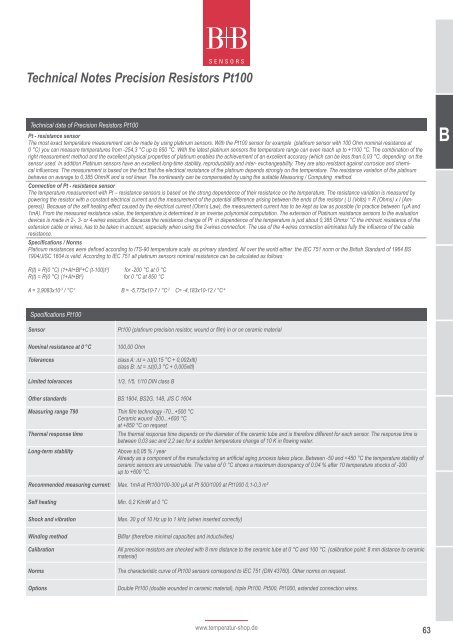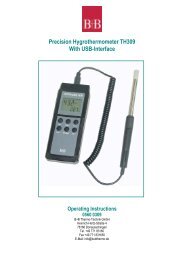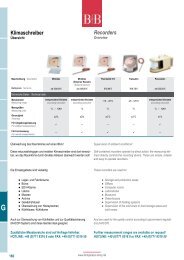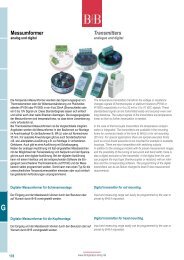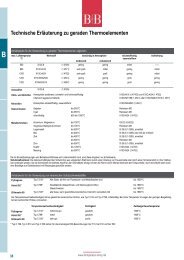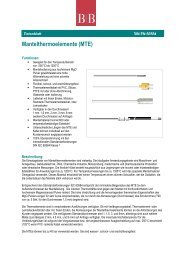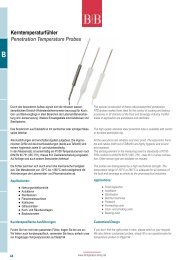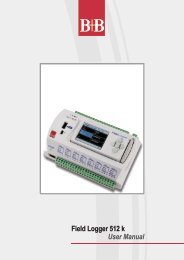B - Temperatur-Shop
B - Temperatur-Shop
B - Temperatur-Shop
You also want an ePaper? Increase the reach of your titles
YUMPU automatically turns print PDFs into web optimized ePapers that Google loves.
Technical Notes Precision Resistors Pt100<br />
Technical data of Precision Resistors Pt100<br />
Pt - resistance sensor<br />
The most exact temperature measurement can be made by using platinum sensors. With the Pt100 sensor for example (platinum sensor with 100 Ohm nominal resistance at<br />
0 °C) you can measure temperatures from -254,3 °C up to 850 °C. With the latest platinum sensors the temperature range can even reach up to +1100 °C. The combination of the<br />
right measurement method and the excellent physical properties of platinum enables the achievement of an excellent accuracy (which can be less than 0,03 °C, depending on the<br />
sensor used. In addition Platinum sensors have an excellent long-time stability, reproducibility and inter- exchangeability. They are also resistant against corrosion and chemical<br />
influences. The measurement is based on the fact that the electrical resistance of the platinum depends strongly on the temperature. The resistance variation of the platinum<br />
behaves on average to 0,385 Ohm/K and is not linear. The nonlinearity can be compensated by using the suitable Measuring / Computing method.<br />
Connection of Pt - resistance sensor<br />
The temperature measurement with Pt – resistance sensors is based on the strong dependence of their resistance on the temperature. The resistance variation is measured by<br />
powering the resistor with a constant electrical current and the measurement of the potential difference arising between the ends of the resistor ( U (Volts) = R (Ohms) x I (Amperes)).<br />
Because of the self heating effect caused by the electrical current (Ohm’s Law), the measurement current has to be kept as low as possible (in practice between 1µA and<br />
1mA). From the measured resistance value, the temperature is determined in an inverse polynomial computation. The extension of Platinum resistance sensors to the evaluation<br />
devices is made in 2-, 3- or 4-wires execution. Because the resistance change of Pt in dependence of the temperature is just about 0,385 Ohms/ °C the intrinsic resistance of the<br />
extension cable or wires, has to be taken in account, especially when using the 2-wires connection. The use of the 4-wires connection eliminates fully the influence of the cable<br />
resistance.<br />
Specifications / Norms<br />
Platinum resistances were defined according to ITS-90 temperature scala as primary standard. All over the world either the IEC 751 norm or the British Standard of 1964 BS<br />
1904/JISC 1604 is valid. According to IEC 751 all platinum sensors nominal resistance can be calculated as follows:<br />
R(t) = R(0 °C) (1+At+Bt 2 +C (t-100)t 3 ) for -200 °C at 0 °C<br />
R(t) = R(0 °C) (1+At+Bt 2 ) for 0 °C at 850 °C<br />
A = 3,9083x10 -3 / °C -1 B = -5,775x10-7 / °C -2 C= -4,183x10-12 / °C -4<br />
Specifications Pt100<br />
Sensor Pt100 (platinum precision resistor, wound or film) in or on ceramic material<br />
Nominal resistance at 0 °C 100,00 Ohm<br />
Tolerances class A: ∆t = ∆t(0,15 °C + 0,002xltl)<br />
class B: ∆t = ∆t(0,3 °C + 0,005xltl)<br />
Limited tolerances 1/3, 1/5, 1/10 DIN class B<br />
Other standards BS 1904, BS2G. 148, JIS C 1604<br />
Measuring range T90 Thin film technology -70...+500 °C<br />
Ceramic wound -200...+600 °C<br />
at +850 °C on request<br />
Thermal response time The thermal response time depends on the diameter of the ceramic tube and is therefore different for each sensor. The response time is<br />
between 0,03 sec and 2,2 sec for a sudden temperature change of 10 K in flowing water.<br />
Long-term stability Above ±0,05 % / year<br />
Already as a component of the manufacturing an artificial aging process takes place. Between -50 and +450 °C the temperature stability of<br />
ceramic sensors are unreachable. The value of 0 °C shows a maximum discrepancy of 0,04 % after 10 temperature shocks of -200<br />
up to +600 °C.<br />
Recommended measuring current: Max. 1mA at Pt100/100-300 μA at Pt 500/1000 at Pt1000 0,1-0,3 m²<br />
Self heating Min. 0,2 K/mW at 0 °C<br />
Shock and vibration Max. 30 g of 10 Hz up to 1 kHz (when inserted correctly)<br />
Winding method Bifilar (therefore minimal capacities and inductivities)<br />
Calibration All precision resistors are checked with 8 mm distance to the ceramic tube at 0 °C and 100 °C. (calibration point: 8 mm distance to ceramic<br />
material)<br />
Norms The characteristic curve of Pt100 sensors correspond to IEC 751 (DIN 43760). Other norms on request.<br />
Options Double Pt100 (double wounded in ceramic material), triple Pt100, Pt500, Pt1000, extended connection wires.<br />
www.temperatur-shop.de<br />
63<br />
B


